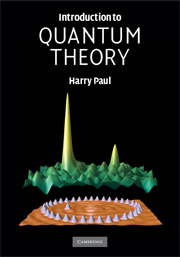8 - Spin and statistics
Published online by Cambridge University Press: 04 June 2010
Summary
Photons and electrons
One of the great technical achievements of the second half of the 20th century was the invention of the laser. With its help extremely intense light could be produced. Furthermore, it even became posssible to excite a single resonator mode so that both the frequency and the propagation direction of the emitted radiation field are extraordinarily sharp. The mere existence of such high-intensity single-mode fields – the real problem that was ingeniously solved was to generate them – is no matter of surprise. We know from classical electromagnetic theory that the amplitude of a monochromatic electromagnetic field can take on arbitrarily large values. This is a direct consequence of the linearity of Maxwell's equations. What does this mean for quantized radiation fields? Certainly, the mentioned property of classical fields must also be retained in the quantum mechanical description. Since the electromagnetic energy is quantized in ‘packets’ of magnitude hν (photons), the number of photons in a given mode must be unlimited, in principle.
All this is very well known. However, it becomes noteworthy when we compare the behaviour of photons with that of electrons. Amazingly, it turns out that an electronic quantum state can be occupied by one electron, at maximum. (Strictly speaking, in the description of the electronic state the spin variable must be included.) This drastic difference in the collective behaviour of photons and electrons could, in fact, not be expected from what we know from single photons and electrons. Both of them have particle-like as well as wave-like properties. However, when many of them are present, they exhibit quite different a demeanour.
- Type
- Chapter
- Information
- Introduction to Quantum Theory , pp. 130 - 143Publisher: Cambridge University PressPrint publication year: 2008



